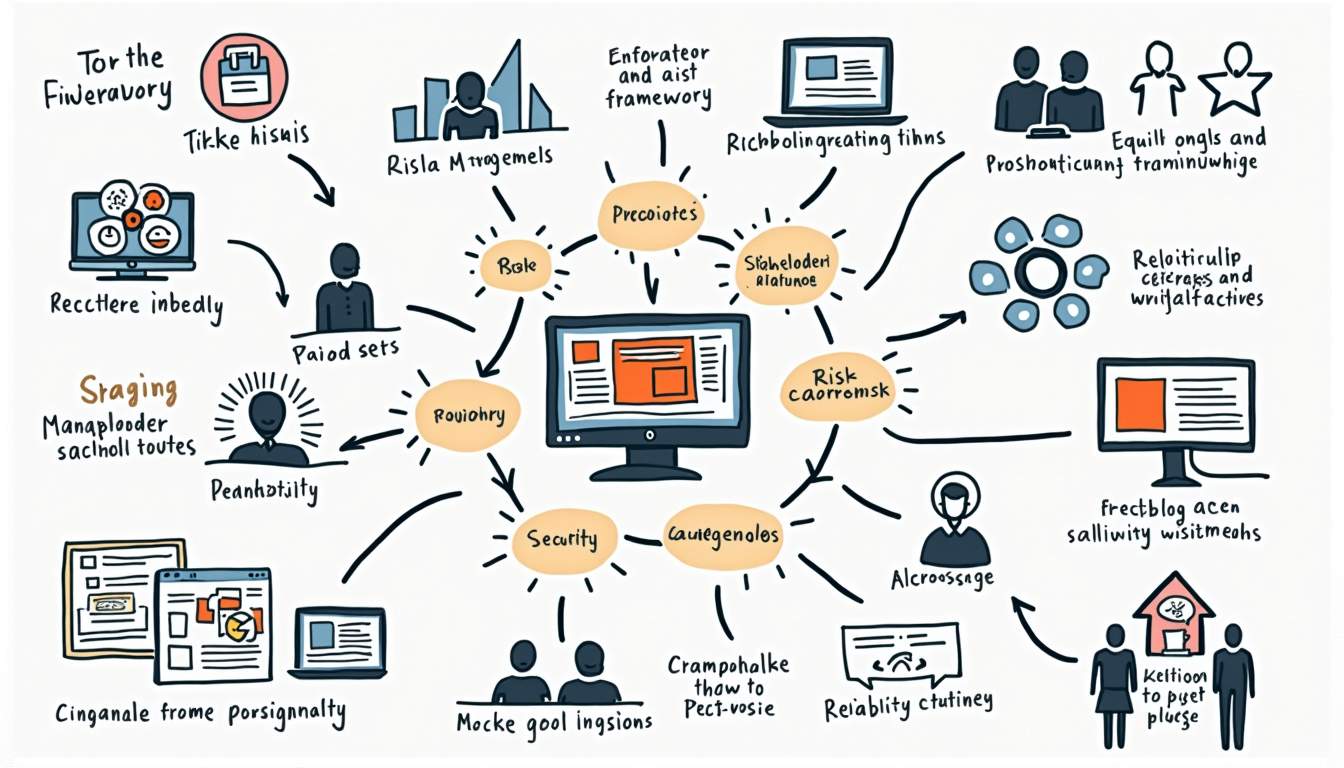In today’s rapidly evolving technological landscape, cyber-physical systems (CPS) play a pivotal role in various sectors, including manufacturing, healthcare, and transportation. These systems integrate computation, networking, and physical processes, creating an intricate web of interactions that can lead to significant benefits but also pose unique challenges. One of the most critical aspects of developing and deploying CPS is understanding and addressing stakeholder concerns. This article delves into the various dimensions of stakeholder engagement, identifying their concerns, and exploring effective strategies to address these issues.
The Importance of Stakeholder Engagement
Stakeholder engagement is not merely a box to check; it is a fundamental component of successful CPS development. Engaging stakeholders early and often can lead to better decision-making, increased trust, and a smoother implementation process. Stakeholders can include anyone from end-users and regulatory bodies to investors and community members. Each group has its unique perspective and concerns that must be acknowledged and addressed.
Building Trust Through Transparency
Transparency is key in fostering trust among stakeholders. When stakeholders are kept informed about the development process, potential risks, and the benefits of the CPS, they are more likely to feel valued and involved. This can be achieved through regular updates, open forums, and accessible documentation that outlines the project’s goals, methodologies, and anticipated outcomes.
Moreover, transparency can help mitigate fears related to privacy and security. As CPS often involves the collection and processing of sensitive data, stakeholders need assurance that their information will be handled responsibly. Providing clear data management policies and demonstrating compliance with regulations can go a long way in alleviating these concerns. Additionally, establishing a feedback loop where stakeholders can voice their opinions and suggestions can further enhance their sense of involvement and ownership in the project.
Understanding Diverse Perspectives
Each stakeholder group has its own set of priorities and concerns. For instance, end-users may prioritize usability and functionality, while regulatory bodies might focus on compliance and safety standards. Understanding these diverse perspectives is crucial for tailoring communication and addressing specific concerns effectively.
Conducting stakeholder analysis can help identify the various groups involved, their interests, and their potential impact on the project. This analysis can inform engagement strategies and ensure that all voices are heard, leading to a more inclusive development process. Furthermore, employing techniques such as surveys, interviews, and focus groups can provide deeper insights into stakeholder expectations and experiences. By actively listening to these insights, project teams can adapt their approaches, ensuring that the final product not only meets technical specifications but also resonates with the needs and desires of its users. This iterative feedback process can foster innovation and enhance the overall quality of the CPS, making it a true reflection of stakeholder input and collaboration.
Common Stakeholder Concerns in CPS
While each stakeholder group may have unique concerns, several common themes often emerge in discussions surrounding cyber-physical systems. Identifying these concerns early in the development process can help teams proactively address them, minimizing potential roadblocks later on.

Security and Privacy Risks
One of the most pressing concerns among stakeholders is the security and privacy of data within CPS. As these systems often involve the collection of vast amounts of data, including personal information, stakeholders are rightfully worried about potential breaches and misuse of this data. Cybersecurity threats can lead to significant financial losses and damage to reputation, making it imperative for developers to prioritize security measures.
To address these concerns, implementing robust security protocols, conducting regular risk assessments, and ensuring compliance with relevant regulations can help build confidence among stakeholders. Additionally, educating stakeholders about the security measures in place can further alleviate fears and promote a sense of safety. Regular updates and transparent communication regarding security practices can also foster trust, as stakeholders will feel more informed and involved in the safeguarding of their data.
Reliability and Performance
Stakeholders also express concerns regarding the reliability and performance of cyber-physical systems. Any failure in these systems can have dire consequences, especially in critical sectors like healthcare or transportation. Stakeholders want assurance that the systems will perform consistently and reliably under various conditions.
To address these concerns, developers should prioritize rigorous testing and validation processes. This includes simulating various scenarios to ensure that the system can handle unexpected situations. Providing stakeholders with performance metrics and reliability data can also help demonstrate the system’s robustness and instill confidence. Furthermore, establishing a feedback loop where stakeholders can report issues or suggest improvements can enhance system performance over time, ensuring that the system evolves to meet their needs effectively.
Ethical Considerations
As CPS increasingly intersects with daily life, ethical considerations have become paramount. Stakeholders often raise concerns about the implications of automation, data usage, and the potential for bias in algorithms. Addressing these ethical concerns requires a thoughtful approach that considers the broader societal impact of the technology.
Engaging stakeholders in discussions about ethical implications can foster a sense of shared responsibility. Establishing ethical guidelines and frameworks for decision-making can also help navigate complex issues, ensuring that the development process aligns with societal values and expectations. Moreover, incorporating diverse perspectives during the design phase can help mitigate biases and promote inclusivity, ultimately leading to systems that serve a wider range of users effectively. By prioritizing ethical considerations, developers can not only enhance stakeholder trust but also contribute to a more equitable technological landscape.
Strategies for Addressing Stakeholder Concerns
Once stakeholder concerns have been identified, it is essential to implement effective strategies to address them. A proactive approach can lead to smoother project execution and greater stakeholder satisfaction.

Establishing Clear Communication Channels
Effective communication is crucial for addressing stakeholder concerns. Establishing clear communication channels allows stakeholders to voice their concerns and receive timely responses. This can include regular meetings, dedicated forums, or digital platforms where stakeholders can engage with the development team.
Moreover, utilizing various communication methods can cater to different stakeholder preferences. Some may prefer face-to-face interactions, while others may find digital communication more convenient. By accommodating diverse communication styles, developers can foster a more inclusive environment. Additionally, leveraging technology such as project management tools and collaboration software can streamline communication, ensuring that all stakeholders are kept in the loop and can easily access relevant information.
Incorporating Feedback Loops
Feedback loops are essential for ensuring that stakeholder concerns are continuously addressed throughout the development process. By actively soliciting feedback at various stages, developers can identify potential issues early and make necessary adjustments. This iterative approach not only improves the final product but also demonstrates to stakeholders that their input is valued.
Surveys, focus groups, and pilot programs can serve as effective tools for gathering feedback. By analyzing the feedback received, developers can prioritize concerns and implement changes that align with stakeholder expectations. Furthermore, creating visual dashboards to track feedback trends can help stakeholders see how their input is influencing project decisions, thereby reinforcing their role in the process and enhancing their commitment to the project’s success.
Creating Stakeholder Advisory Boards
Establishing stakeholder advisory boards can provide ongoing support and guidance throughout the development process. These boards can consist of representatives from various stakeholder groups, ensuring that diverse perspectives are considered in decision-making.
Advisory boards can facilitate open dialogue, allowing stakeholders to express their concerns and contribute to the development of solutions. This collaborative approach not only enhances stakeholder engagement but also fosters a sense of ownership among stakeholders, leading to greater buy-in for the project. Additionally, regular workshops and brainstorming sessions with the advisory board can stimulate innovative ideas and help in addressing potential challenges before they escalate. By involving stakeholders in this way, organizations can cultivate a culture of collaboration that extends beyond the advisory board, encouraging all stakeholders to actively participate in the project’s evolution.
Case Studies of Successful Stakeholder Engagement
Examining case studies of successful stakeholder engagement can provide valuable insights into effective strategies for addressing concerns in cyber-physical systems. These examples illustrate how proactive engagement can lead to positive outcomes.
Smart Transportation Systems
In the development of smart transportation systems, stakeholder engagement played a crucial role in addressing concerns related to safety and efficiency. By involving city planners, transportation agencies, and community members in the planning process, developers were able to gather diverse perspectives on the system’s design and implementation.
Regular workshops and public forums allowed stakeholders to voice their concerns and contribute ideas. As a result, the final system incorporated features that enhanced safety, reduced congestion, and improved overall user experience. This collaborative approach not only addressed stakeholder concerns but also fostered community support for the project.
Healthcare Monitoring Systems
In the realm of healthcare, the development of remote monitoring systems for patients involved extensive stakeholder engagement to address privacy and reliability concerns. Healthcare providers, patients, and regulatory bodies were all involved in discussions about data usage, security measures, and system reliability.
By establishing clear communication channels and incorporating feedback from stakeholders, the development team was able to create a system that met regulatory standards while also addressing patient concerns about data privacy. The result was a widely accepted system that improved patient outcomes and enhanced the overall quality of care.
Conclusion
Identifying and addressing stakeholder concerns in cyber-physical systems is a critical aspect of successful development. By engaging stakeholders early, fostering transparent communication, and implementing effective strategies to address concerns, developers can create systems that not only meet technical requirements but also align with stakeholder expectations.

As the landscape of technology continues to evolve, the importance of stakeholder engagement will only grow. By prioritizing stakeholder concerns and fostering collaboration, developers can ensure that cyber-physical systems are not only innovative but also responsible and beneficial to society as a whole.
Ultimately, the success of cyber-physical systems hinges on the ability to navigate complex stakeholder dynamics. By embracing an inclusive approach that values diverse perspectives, developers can create solutions that resonate with all stakeholders, paving the way for a future where technology enhances lives while addressing the concerns of those it impacts.
Take Control of Your Cyber-Physical Systems with Cybersort
Understanding stakeholder concerns is just the beginning. With Cybersort, you can take proactive steps to document, structure, and secure your plant’s digital infrastructure. Our platform empowers you to enhance operations, fortify cybersecurity, and drive digital transformation effectively. Ready to see how Cybersort can transform your cyber-physical systems? Book a discovery call today and take the first step towards a more controlled and secure digital future.


